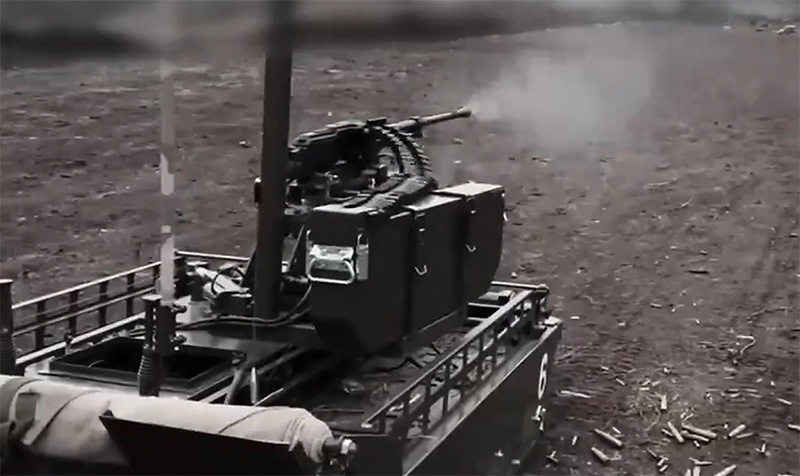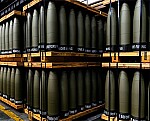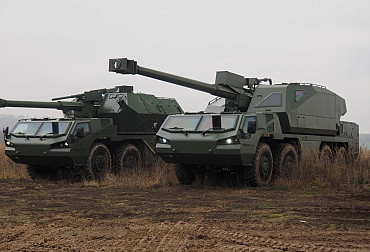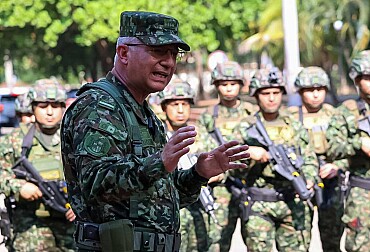U.S. aid to Ukraine has the green light. Russia steps up attacks, ground drones enter the war
The nearly $61 billion aid package for Ukraine has finally passed the U.S. legislative approval process. According to U.S. President Joe Biden, the first part of the aid, a third of which is intended for military support, can now go to the Russian-occupied country. Military equipment, ammunition, air defence systems and other weapons are to go to Ukraine from U.S. warehouses in Germany and Poland. However, experts say that there is a need to persevere and to secure support from the West in the future. The Russians are responding by intensifying attacks on Ukrainian cities with missiles and drones. Drones in particular are now being used in greater numbers by both sides on the front line, including ground-based types.

It took many months of internal political wrangling and wrangling before the United States was able to reach agreement on a massive military foreign aid package worth a total of $95 billion. After Taiwan and Israel, the largest portion - $60.8 billion - is going to Ukraine, with the bulk of it ($23 billion) going to military aid. That includes replenishing U.S. warehouses so that local manufacturers are prepared for future support to Kiev, according to U.S. lawmakers. The rest is for humanitarian purposes and economic support for the war-torn country.
The purpose of the approved aid, according to the Americans, is to regain Ukrainian superiority on the battlefield after months of a war of attrition, with moderate advances reported mainly by the Russians. "In terms of combat operations over the next few months, the Ukrainians are going to have to regroup substantially in order to start using all these new supplies after having limited ammunition and other supplies and to ensure that they can defend their positions," an unnamed senior U.S. official commented, according to Reuters. "So I wouldn't anticipate any large-scale counter-offensive in the near term," he said, adding that he nevertheless expected more frequent and accurate responses from Ukrainian forces, including from Russian positions in occupied Crimea.
The U.S.-based Institute for the Study of War warns that Western aid deliveries may in turn lead to more intense Russian attacks. In fact, these are already occurring today, particularly along the front line, from the northern city of Kharkiv, which has experienced almost daily Russian shelling in recent weeks, to villages and towns in the Donetsk region, particularly in the Chasiv Yar area. "U.S. officials are reportedly concerned that the latest U.S. military aid package to Ukraine may not be enough for Ukraine to regain all of its territory," reads an analysis by the Institute for the Study of War (ISW). "Moreover, U.S. military aid is only part of what Ukraine currently needs; but Ukraine itself is working to address other wartime needs - most notably, human resource challenges and the expansion of its defense industrial base," the institute adds.
The long war is yet to come
"Ukraine needs to use 2024 to rebuild its forces for the long war. Europe's goal should be to put itself in a position to potentially fill the gap that the United States could re-create in the future if it does not approve another package," Max Bergmann, director of the Europe, Russia and Eurasia program at the Center for Strategic and International Studies in Washington, told Reuters. Concern about future aid has been repeatedly expressed in the past by Ukrainian officials themselves, and the U.S. is aware of this. However, some changes may come after the November elections, even Donald Trump has finally come out in favour of approving financial support for Ukraine, so if he is successful against the current president, it can be expected that U.S. supplies will not completely end.
Despite future concerns, the current Biden administration is working on another package that should focus on ongoing support, particularly for air defence. According to the AP, this would be $6 billion released incrementally for Patriot missiles. These are what Kiev is now acutely seeking to counter frequent Russian attacks. There are already several Patriot missiles in Ukraine, but Volodymyr Zelensky says the country needs more, at least 25, according to estimates, in order for Ukraine to gain superiority in air defense. NATO countries are therefore now looking for them, as well as other systems (IRIS-T, ATACMS or HIMARS) that the Western partners may lack. The situation is worse for the eastern wing of the alliance, such as Poland or the Baltic states, which themselves fear a possible escalation of conflict from the east and are unwilling to give up their systems. There should be more willingness to help from Germany and other Western European allies.
A new dimension to drone warfare
Since the beginning of the conflict, drones have been an integral part of the Ukrainian defence and counter-attacks.Among other things, drones have been supplied to Ukraine thanks to the activities of various civic initiatives in the Czech Republic and Slovakia and have become an integral part of the arsenal used against Russian aggressors. A hit are FPV drones controlled by a first-person operator, often suicidal - carrying different types of charges depending on their payload and use in the field. The drones range from the smallest at sub-thousands of crowns to large, small helicopter-like vehicles capable of traveling hundreds of kilometers and are widespread across the battlefield.
Their effectiveness on the modern battlefield was noted by the Russians some time ago and drones are increasingly being deployed in the same manner as the Ukrainian defenders, although they do not yet have the upper hand in this regard. The need to increase their production and supply was stressed by Vladimir Putin last December. In addition to the larger Iranian Shahid suicide drones, smaller modern drones from China are beginning to flow to the Russians.
"Both Russian and Ukrainian commentators and bloggers often point out that the adversary has more drones and can control them better," says Russian drone expert Samuel Bendett, according to Forbes magazine, adding that the Ukrainians are mainly referring to the Shahids raiding their cities, and the Russians to the FPV drones on the front lines, and the situation is already forcing both sides to change tactics. Kiev is temporarily withdrawing its brand new U.S.-made Abrams M1A1 tanks from frontline positions due to drone threats, and the Russian army in turn has decided to convert a number of its tanks into so-called turtles, adding various structures around the turret to repel the drones or initiate an explosion so as not to endanger the tank crews. Certain Russian drones are then deployed to hunt down Ukrainian ones.
A relative novelty is then the deployment of more ground-based remotely piloted vehicles (UGVs), with the Ukrainians, for example, deploying a demining machine as part of this category of systems. The Russians, in turn, have shown a small robot used for logistics and other unmanned systems with associated machine guns, which they refer to as the Kuryr. "Another video shows what looks like a Kurier, a small combat UGV that took part in the March battle and was destroyed by Ukrainian FPV drones," Samuel Bendett then commented on his X account on the latest video released by the Russians showing just the newly used ground drones.
Another video of what appear to be “Curriers” (Курьер) small combat UGVs that participated in a March battle and were destroyed by Ukrainian FPVs. https://t.co/CrLPwOH3Q5 pic.twitter.com/kpyekaTxvs
— Samuel Bendett (@sambendett) April 23, 2024
The Ukrainians also have their own combat UGV, it resembles a quad bike with a cannon for a driver and is named the Armoured Personnel Carrier. This system has also already been deployed in live combat and is being praised by the Ukrainians as a new option for repelling Russian attacks.










